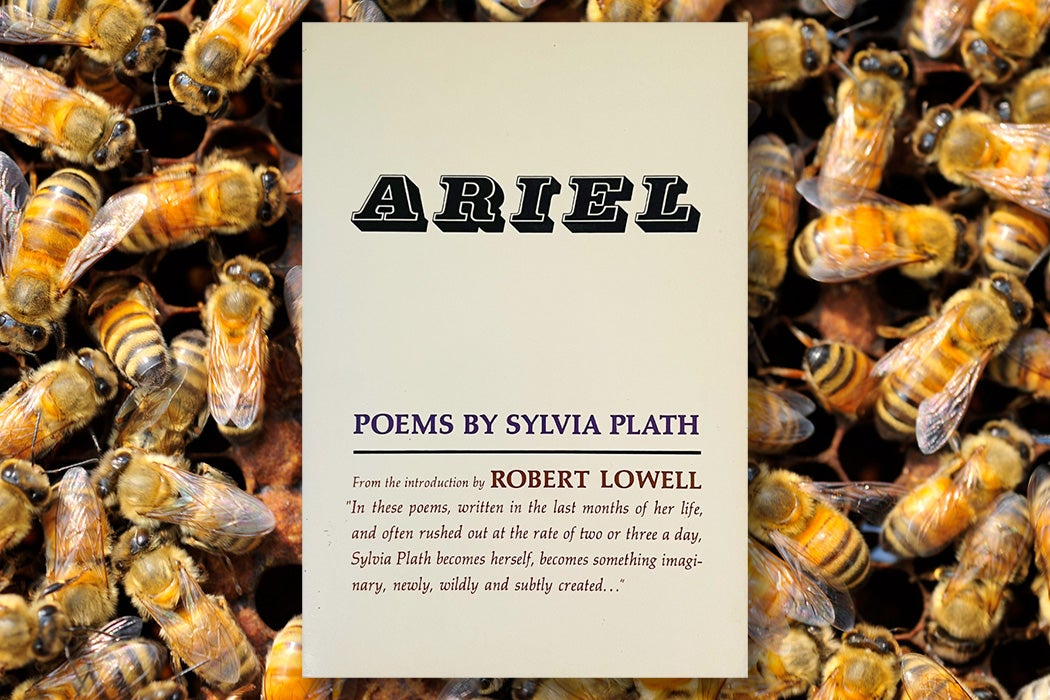Perhaps among the bees, peaceful and well-organized social creatures that they are, American confessional poet Sylvia Plath found a solid sense of community, support, and connection that she was missing on the home front. Add to that the affective element of hereditary nostalgia—Plath’s late father, Otto Plath, was a respected biologist who published a book in 1934 on the habits of bumblebees—and what was produced was a series of poems that are notably more grounded and less volatile than anything she ever wrote about her father’s early death from diabetes or the abysmal health care she received for her lifelong mental illness.
Sylvia Plath’s healthy relationship with bees and their impact on her work in times of debilitating writer’s block could even be described as that of a genius and their muse. She was a beekeeper herself and likely composed poems in her head while interacting with her bees and absorbing their conflict-free productivity. Pun fully intended, they gave her a much-needed buzz.
Academics seem inclined to refer to the fruit of Plath’s labors—the writing, not the beekeeping—simply as “the bee poems,” giving them something of a distinction for having more neatly constructed narratives than her other output. Indeed, there was a narrative being told by a writer who may have had a touch of Beatrix Potter in her. Plath reportedly wanted a selection of her “bee poems” published in a specific sequence at the end of her collection Ariel, but she passed away from suicide before she could give the editors and publishers proper instructions. Her estranged husband, Ted Hughes, who was not such a devoted beekeeper and seemingly didn’t understand her vision, published the collection incorrectly in 1965, ending the volume with her death-themed poems instead. Where Plath saw order in the natural world, he saw disorder. And it was, by all accounts, not the first time in their marriage that his will had overruled her own.
Scholars have worked hard to avenge Plath and defend her expertise in her own craft, overriding Hughes’s infamous arrogance and insisting that Plath, while alive, was perfectly capable of making her own creative decisions, despite her mental illness. Literature scholar Janine Rogers and historian of science Charlotte Sleigh, writing for The Review of English Studies, note that Plath’s command of her chosen subject is beyond amateur.
“It would be fruitless to speculate about the extent to which Sylvia Plath was aware of her father’s entomological knowledge,” they write, “however, what one can say with certainty was that the latter formed part of a broadly shared set of images and metaphors that connected the insect realm with the human.”
Specifically, it was the “hive identity” of bees that gave Plath a tool for examining her own poetic practice. Rogers and Sleigh focus on mereology, the study of the relationship between parts and whole, arguing that Plath’s knowledge of the interdependence of a single bee and the hive would have provided a model for thinking about the “formal and linguistic aspects of poetry, as well as on the place of the individual within the lyric tradition as a whole.”
Weekly Newsletter
Literature and humanities scholar Mary Lynn Broe argues that Plath’s bee poems reflect
a curve of maturation in their dramatic movement from youthful naivete and disillusionment (“Beekeeper’s Daughter”) to vigorous exploration of the contradictions inherent in power (“Arrival of the Bee Box,” “The Bee Meeting,” and “Stings”) and finally to a grasp of a new mode of power (“Wintering,” “Swarm”), one reconciled to simple factual limitation.
Broe speculates that Plath was imaginatively trying to make sense of her own situation and work by inventing a tale in which a beekeeping narrator identifies with the queen bee. Over the course of six poems, a “naive young woman” slowly recognizes that the incontestable power of the queen ends in “a tragic nuptial flight, a blend of ecstasy life and death.” The narrator,
experiences a moment of identification with the queen bee’s isolation, a sense of the tragic nuptials of the queen and her mate, and finally, recognition of a complex commingling of life and death—an interrelationship crucial to all the bee poems.
Broe argues that the poems’ elucidation of the tangled relationships of queen to power; to inertia; to hive, worker bee, and drone; to swarms; and even to other queen bees “demonstrates Plath’s vivisection of the concept and function of power” and its relationship to her as poet and person. The poems show Plath “examin[ing] the often contradictory workings the dimensions of the self that might be recovered the aesthetic process.”
In this sense, Plath’s actual beekeeping, a practice which delighted her even as her marriage to Ted Hughes was crumbling, can be read as her rough draft, with her bee poems as her finished work, her excavation of self. And as Plath illustrates in the poems, the sweetest part of beekeeping may not actually be the honey, but the bees themselves.
Support JSTOR Daily! Join our membership program on Patreon today.







